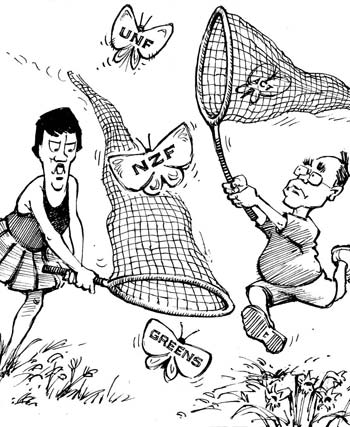Story summary
New Zealand’s first political parties
For most of the 19th century New Zealand’s Parliament didn’t have formal political parties. Members of Parliament (MPs) were independents who were voted into Parliament by their local electorates.
The first formal political party was the Liberal Party, which won enough votes at the 1890 election to become the government in 1891. Grouping together as a party gave them advantages in gaining votes and financial support. In 1909 the right-wing opposition came together and formed the Reform Party, which became the government in 1912.
Labour and National
The Labour Party, which was left-wing and represented workers and trade unions, was formed in 1916 and became the government in 1935. The next year the Liberal and Reform parties merged to form the National Party. For the next 60 years, governments were formed by one of these two parties, as between them they won almost all the seats in Parliament. Labour usually won urban seats, and National usually won rural seats.
Smaller parties before 1993
Despite the dominance of the National and Labour parties, smaller political parties contested elections, and a few gained seats in Parliament.
- Social Credit, which believed in reform of the financial sector, was founded in the 1950s. It won four seats in Parliament between 1966 and 1984.
- The Values Party, founded in the 1970s, was aligned with the peace, women’s and environmental movements. It was a precursor of the Green Party.
- The New Zealand Communist Party was small, but was influential among workers’ movements.
- The New Zealand Party was set up in 1983 to draw votes away from the National government in the 1984 election.
- The McGillicuddy Serious Party was a joke party that humorously contested elections in the 1980s and 1990s.
- Mana Motuhake was a Māori party set up by former Labour MP Matiu Rata.
- Christian Heritage and the Christian Democrats both lobbied for the Christian vote.
- Jim Anderton, a former Labour MP, started the NewLabour Party in 1989.
- In 1991 a number of small parties, including Mana Motuhake, NewLabour and the Green Party (formed in 1990), joined together to form the Alliance. They won two seats in 1993.
- New Zealand First was started by former National Party MP Winston Peters in 1993. It won two seats in that year’s election.
Small parties under MMP
In 1996 New Zealand had its first election under the MMP (mixed-member proportional) system. Voters cast two votes – one for the person they want to represent their local electorate, and one for a political party. The proportion of seats in Parliament is decided by the party vote. This has made it easier for smaller parties to get into Parliament, and has meant that the party that gets the most votes (typically Labour or National) usually has to work with smaller parties to form a government.
The first MMP government was formed by the National Party in coalition with New Zealand First.
Other parties that have been represented in Parliament since the introduction of MMP are:
- ACT, a far-right party
- the Māori Party (later Te Pāti Māori), formed in 2004, and its offshoot the Mana Party
- United, which became UnitedFuture
- the Green Party, which left the Alliance in 1997
- Jim Anderton’s Progressive Party, formed after a split in the Alliance in 2002.





